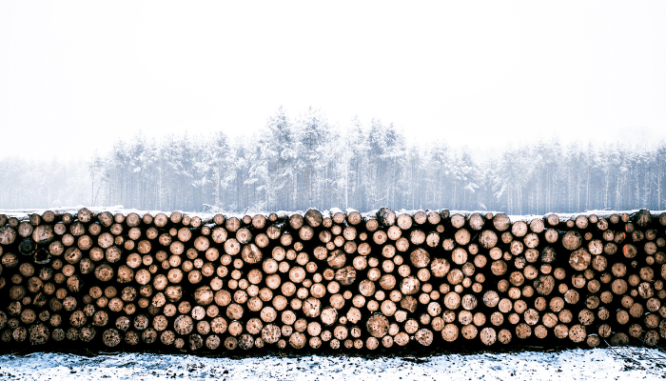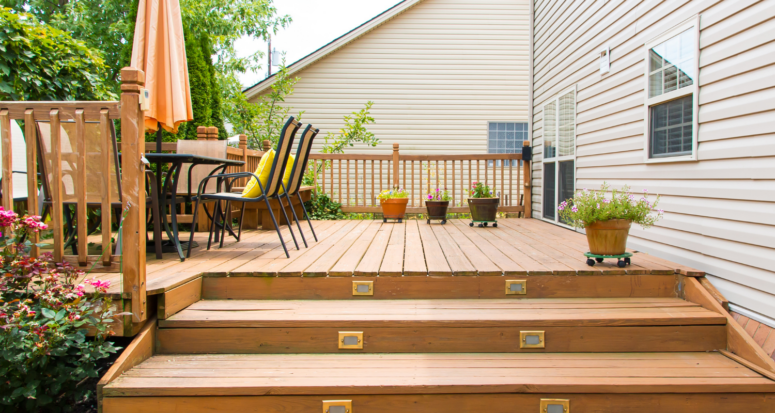What’s the Cost to Build a Deck as Outdoor Add-Ons Gain Popularity?
- Published on
- 6 min read
-
 Emma Diehl Contributing AuthorClose
Emma Diehl Contributing AuthorClose Emma Diehl Contributing Author
Emma Diehl Contributing AuthorEmma's work has been featured in Huffington Post, NPR and XOJane. When she's not combing her neighborhood for open houses, she's writing about technology, real estate or data.
At HomeLight, our vision is a world where every real estate transaction is simple, certain, and satisfying. Therefore, we promote strict editorial integrity in each of our posts.
A deck addition has always been a wonderful way to boost the enjoyment of your home. Who doesn’t love a dedicated space to dine alfresco, watch the sunset, and get some fresh air? But as the pandemic encourages outdoor activities for safety and grounds Americans at home, deck builds have skyrocketed in popularity beyond their usual demand.
As a result, the cost to build a deck is higher than it used to be. One report notes that prices for a 16-foot deckboard — often used for building home decks — rose from $18 pre-pandemic to a peak of $34 in the fall. Prices have since leveled a bit but will still include a “coronavirus premium,” so to speak, for the foreseeable future.
If your backyard space is longing for a deck, consult this pricing guide which includes several remodeling estimates from reputable home improvement sites and a full breakdown of the expenses you’re likely to encounter. For additional insights, we gathered a sample deck quote estimate from a contractor who walked us through how costs for this project typically shake out.
The deck of your dreams awaits! But first… it’s time to budget.

Low, high, and average deck costs: What’s the big picture?
Just like any home improvement project, factors like the materials you select, the size of the addition, and which upgrades you opt for (such as built-in seating or sun shade) will impact the overall cost of your deck build. As a starting point, however, let’s review some broad estimates for this project reported by some of the major home improvement brands:
Source: HomeAdvisor
Average deck addition cost: $7,682
Average cost per square foot: $30-$60 per square foot
Low and high end deck addition range: $4,152-$11,212
Methodology: HomeAdvisor’s estimates are based on the cost of 14,205 user-submitted projects.
Source: Fixr
Average deck addition cost: $12,000
Average cost per square foot: $14-$44 per square foot
Low and high end deck addition range: $2,000-$22,000
Methodology: Fixr gathers data from the latest cost studies, U.S. reports, specialty associations, vendor sites, and a 90,000+ local contractor network.
Source: HomeGuide
Average deck addition cost: $6,280
Average cost per square foot: $15-$30 per square foot
Low and high end deck addition range: $1,200-$14,000
Methodology: HomeGuide tracks estimates across the country from its network of 30,000 local professionals with millions of project estimates.
Based on these aggregate cost estimates, you can expect the cost of your deck to range anywhere from $2,000 for a simple addition to $22,000 for a larger, upscale version.
Breaking down your deck expenses, line by line
Of all the expenses that will go into your deck addition, the three biggest factors likely to impact your final cost include labor, square footage, and your selected materials.
Labor
According to HomeAdvisor, labor costs to build your deck typically account for about 50% of the budget. You can attempt to cut down on labor costs by timing the project in the offseason or doing some of the work yourself. If you schedule construction in the offseason, you might be able to negotiate rates and a quicker project timeline.
According to the National Association of Home Builders, completing the labor yourself can cut the average $31 per square foot costs of building a deck in half. That might mean clearing the yard, digging the supports, or cutting some of the decking. But be forewarned that DIY projects take on average 3x longer than professional installations.
Size
The bigger you plan to build your deck, the more it’ll cost you. Not only do you need more materials for a larger addition, but the design will become more complicated as square footage increases. Plus, there’s more labor involved. Here are a few ballpark estimates for some standard deck sizes:
10×16
Price range: $2,240 to $7,040
Typical features, added costs: a 10×16 deck can accommodate built-in benches and an eating area. This size deck can be a platform or raised.
12×20
Price range: $3,360 to $10,560
Typical features, added costs: A deck this size could support a second level or wrap around the home with both a dining and entertaining space.
12×16
Price range: $7,200 – $10,800
Typical features, added costs: A deck of this size is often raised, with a set of stairs leading to the rest of the yard.
Materials
The material you choose to build your deck with will not only impact the upfront cost of the project — it could also affect how much you pay to maintain the deck for years to come. Here’s how much you can expect to spend on materials, as well as their benefits and drawbacks:
Pressure-treated wood ($1.50-$2.50 per square foot)
Pros:
- Used in 75% of deck projects in the U.S
- Treated to ingrain preservative agents deep into the lumber to keep rot, pests, and mold away
Cons:
- Lower grade wood means ongoing maintenance, including regular seling
- Planks and pieces will eventually crack and warp (expected lifespan of 50 years)
Composite ($7-$10 per square foot)
Pros:
- So long as there’s a shortage of lumber, 51% of top real estate agents recommend composite material as an alternative to wood from an ROI perspective
- Made from plastic and wood fiber, composite decking will never rot, warp, or mold
- Still looks like wood in natural finishes
Cons:
- Will need occasional scrubbing to prevent mildew
- Non-natural finishes can look like plastic
Tropical hardwood ($8-$12 per square foot)
Pros:
- Hard, durable, and are naturally resistant to mold and insects
- Rich brown aesthetic
Cons:
- Material density requires you to drill pilot holes, making the process more labor-intensive
- Doesn’t stain well and must be preserved with a UV-blocking stain every 2-3 years
- Luxury pricing
Redwood and cedar ($3.75-$8 per square foot)
Pros:
- Resistant to rot and decay
- Lightweight and naturally rich in color
Cons:
- Requires annual pressure washing and a new coat of finish every 3-4 years
- Expensive price point
PVC ($4-$13 per square foot)
Pros:
- Made from plastic, which means virtually no maintenance
- Lifespan of 30 years
Cons:
- Looks, feels, and even sounds different underfoot from a traditional wood deck
- High-end PVC that feels more like wood can be expensive
Aluminum ($12-$15 per square foot)
Pros:
- 3-4x stronger, and 2-3x lighter than most alternatives
- Resistant to just about everything, including rust
- Finished to look like wood grain and stays cooler than the alternatives in direct sun.
Cons:
- It’s the most expensive material
- Won’t give you the wood deck aesthetic

The ‘coronavirus premium’ on today’s deck builds
In the wake of COVID-19, home improvement projects have skyrocketed, impacting the cost of labor and materials. In July, deck construction was up 275% from the previous year as homeowners rushed to add more livable space to their properties.
CNBC reported that some homeowners might be paying 50% more for labor during this period of high demand. And according to the National Association of Home Builders, the cost of lumber rose 80% between April and August 2020, and its cost has yet to fall.
“It’s hard to get materials right now. We’ve noticed that the price of wood has gone up tremendously,” says Austin, Texas-area agent Jessica Trad who’s never seen a surge in price like this during her nearly two decades of experience.
In response, homeowners are opting to use wood alternatives for their deck and other outdoor projects, even ones that would in the past have been more before the lumber pricing surge. When Trad’s mother recently rebuilt a fence on her property, she opted to use metal instead of wood because the cost was nearly identical.
While the pricing premium of wood will make building a deck more expensive, it could push sellers to use higher-grade materials that require less upkeep, in the long run, says Trad, like composite decking or even aluminum.
Deck addition costs: A real-life example
We reached out to Sue Sirrs, an internationally acclaimed landscape architect and principal at Outside! Planning and Design Studio, to get firsthand cost break down of a recent deck build.
“It’s important to scale your deck to your budget, and not the other way around! During the brainstorming phase, make sure your plans measure up to the budget range you have in mind,” reminds Sirrs.
Here Sirrs priced out a recent 10×16 build, including labor and landscaping:
| 10 x 16 Deck Build | Labor | Materials (estimate) | Cost |
| Decking Materials | $21 per sq foot | $3,360 | |
| Post, Beams, & Footing | $250 | $250 | |
| Site Prep (leveling) | $400 | $400 | |
| Build | $6,500 | $6,500 | |
| Total | $10,510 |
Because Sirrs specializes in sustainable builds, the cost of client materials often trend higher than average and have only become more expensive due to supply chain issues triggered by the pandemic. Sirrs also tells clients to allot at least 2.5 to 3 times material cost for labor and installation, often the most expensive element of her builds.

Tips to maximize the enjoyment and value of your deck
Here are some ideas to keep in mind as you start building out your deck:
- Add a fire pit
HomeLight’s Q4 2020 survey of over 1,000 real estate agents found that a firepit is the no. 1 feature homebuyers want to see in a backyard, with 54% of agents citing it as a top outdoor upgrade for resale. Keep in mind that placing certain types of fire pits on wood or composite decking can be a hazard. Depending on your deck material, you may prefer to set up your firepit seating in an adjacent area for safety. - Install shade in warmer climates
“Here in Texas, you get triple digits in the summer,” says Trad. Most of her buyer clients prefer a covered deck they can use all day without getting too hot. HomeLight’s survey confirms that screened-in spaces — an extra cost of $1,000- $1,900 — and any kind of sun shade are popular outdoor feature upgrades in the South. - Wire electricity outside for a more livable space
Adding electricity and an outlet or two to your deck will make the space feel even more usable. “Electrical is a benefit,” says Trad. “You can install ceiling fans, add lighting, even plug in a string of lights, which is just really cute.” Installing electrical wiring and an outlet outside cost between $176-$271, on average.
How much value will a deck addition add?
A new deck isn’t just a place for you to entertain and enjoy yourself — it’ll also add value to your home. According to Remodeling Magazine’s 2020 Cost vs. Value report, you’ll recoup 72.1% on a wooden deck addition and 66.8% on a composite deck addition.
How much value your deck adds will depend on whether you used high-end or midrange materials, the overall square footage of the deck, and whether it includes any kind of screen or enclosure for increased use throughout the year. If anything, a deck has only become more valuable over the past year, so chances are you won’t regret adding one so long as you stick to your budget!
Header Image Source: (Irina Mos / Shutterstock)
